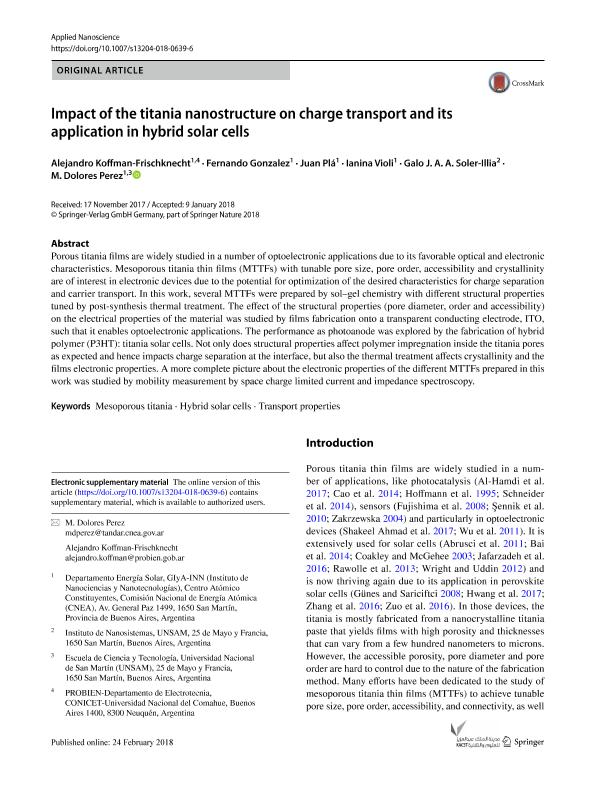Mostrar el registro sencillo del ítem
dc.contributor.author
Koffman Frischknecht, Alejandro

dc.contributor.author
Gonzalez, Fernando Daniel

dc.contributor.author
Pla, Juan Carlos

dc.contributor.author
Violi, Ianina Lucila

dc.contributor.author
Soler Illia, Galo Juan de Avila Arturo

dc.contributor.author
Perez, Maria Dolores

dc.date.available
2019-12-30T14:31:32Z
dc.date.issued
2018-03
dc.identifier.citation
Koffman Frischknecht, Alejandro; Gonzalez, Fernando Daniel; Pla, Juan Carlos; Violi, Ianina Lucila; Soler Illia, Galo Juan de Avila Arturo; et al.; Impact of the titania nanostructure on charge transport and its application in hybrid solar cells; Springer; Applied Nanoscience; 8; 4; 3-2018; 665-673
dc.identifier.issn
2190-5509
dc.identifier.uri
http://hdl.handle.net/11336/93200
dc.description.abstract
Porous titania films are widely studied in a number of optoelectronic applications due to its favorable optical and electronic characteristics. Mesoporous titania thin films (MTTFs) with tunable pore size, pore order, accessibility and crystallinity are of interest in electronic devices due to the potential for optimization of the desired characteristics for charge separation and carrier transport. In this work, several MTTFs were prepared by sol–gel chemistry with different structural properties tuned by post-synthesis thermal treatment. The effect of the structural properties (pore diameter, order and accessibility) on the electrical properties of the material was studied by films fabrication onto a transparent conducting electrode, ITO, such that it enables optoelectronic applications. The performance as photoanode was explored by the fabrication of hybrid polymer (P3HT): titania solar cells. Not only does structural properties affect polymer impregnation inside the titania pores as expected and hence impacts charge separation at the interface, but also the thermal treatment affects crystallinity and the films electronic properties. A more complete picture about the electronic properties of the different MTTFs prepared in this work was studied by mobility measurement by space charge limited current and impedance spectroscopy.
dc.format
application/pdf
dc.language.iso
eng
dc.publisher
Springer

dc.rights
info:eu-repo/semantics/openAccess
dc.rights.uri
https://creativecommons.org/licenses/by-nc-sa/2.5/ar/
dc.subject
Mesoporous titania
dc.subject
Hybrid solar cells
dc.subject
Transport properties
dc.subject
Hybrid solar cells
dc.subject.classification
Ingeniería Eléctrica y Electrónica

dc.subject.classification
Ingeniería Eléctrica, Ingeniería Electrónica e Ingeniería de la Información

dc.subject.classification
INGENIERÍAS Y TECNOLOGÍAS

dc.subject.classification
Ingeniería Eléctrica y Electrónica

dc.subject.classification
Ingeniería Eléctrica, Ingeniería Electrónica e Ingeniería de la Información

dc.subject.classification
INGENIERÍAS Y TECNOLOGÍAS

dc.title
Impact of the titania nanostructure on charge transport and its application in hybrid solar cells
dc.type
info:eu-repo/semantics/article
dc.type
info:ar-repo/semantics/artículo
dc.type
info:eu-repo/semantics/publishedVersion
dc.date.updated
2019-10-21T13:34:48Z
dc.identifier.eissn
2190-5517
dc.journal.volume
8
dc.journal.number
4
dc.journal.pagination
665-673
dc.journal.pais
Alemania

dc.description.fil
Fil: Koffman Frischknecht, Alejandro. Comision Nacional de Energía Atómica. Gerencia del Área de Investigación y Aplicaciones no Nucleares. Gerencia Física (CAC). Grupo Energía Solar; Argentina. Consejo Nacional de Investigaciones Científicas y Técnicas. Centro Científico Tecnológico Conicet - Patagonia Norte. Instituto de Investigación y Desarrollo en Ingeniería de Procesos, Biotecnología y Energías Alternativas. Universidad Nacional del Comahue. Instituto de Investigación y Desarrollo en Ingeniería de Procesos, Biotecnología y Energías Alternativas; Argentina
dc.description.fil
Fil: Gonzalez, Fernando Daniel. Comision Nacional de Energía Atómica. Gerencia del Área de Investigación y Aplicaciones no Nucleares. Gerencia Física (CAC). Grupo Energía Solar; Argentina. Consejo Nacional de Investigaciones Científicas y Técnicas; Argentina
dc.description.fil
Fil: Pla, Juan Carlos. Consejo Nacional de Investigaciones Científicas y Técnicas; Argentina. Comision Nacional de Energía Atómica. Gerencia del Área de Investigación y Aplicaciones no Nucleares. Gerencia Física (CAC). Grupo Energía Solar; Argentina
dc.description.fil
Fil: Violi, Ianina Lucila. Consejo Nacional de Investigaciones Científicas y Técnicas; Argentina. Comision Nacional de Energía Atómica. Gerencia del Área de Investigación y Aplicaciones no Nucleares. Gerencia Física (CAC). Grupo Energía Solar; Argentina
dc.description.fil
Fil: Soler Illia, Galo Juan de Avila Arturo. Consejo Nacional de Investigaciones Científicas y Técnicas; Argentina. Universidad Nacional de San Martin. Instituto de Nanosistemas; Argentina
dc.description.fil
Fil: Perez, Maria Dolores. Universidad Nacional de San Martín. Escuela de Ciencia y Tecnología; Argentina. Consejo Nacional de Investigaciones Científicas y Técnicas; Argentina. Comision Nacional de Energía Atómica. Gerencia del Área de Investigación y Aplicaciones no Nucleares. Gerencia Física (CAC). Grupo Energía Solar; Argentina
dc.journal.title
Applied Nanoscience
dc.relation.alternativeid
info:eu-repo/semantics/altIdentifier/url/http://link.springer.com/10.1007/s13204-018-0639-6
dc.relation.alternativeid
info:eu-repo/semantics/altIdentifier/doi/https://doi.org/10.1007/s13204-018-0639-6
Archivos asociados
